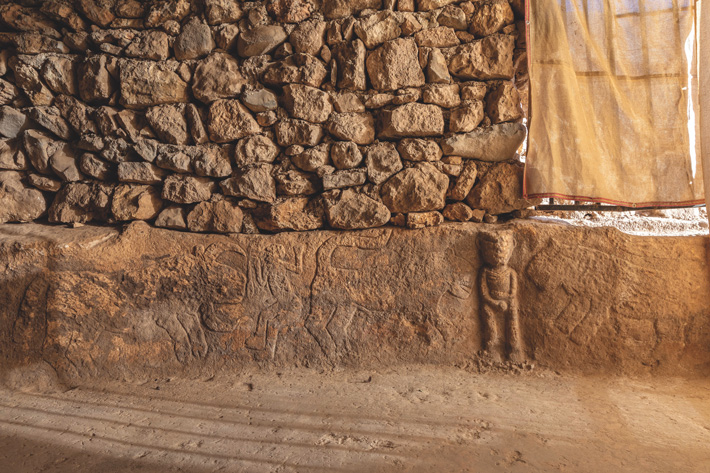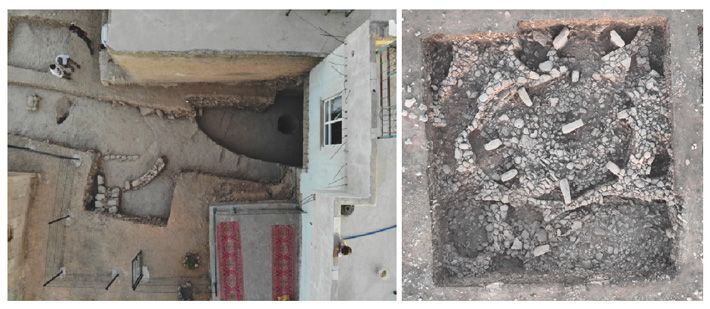 In 2021, in the modern village of Sayburç, archaeologist Eylem Özdoğan of Istanbul University discovered a rare Pre-Pottery Neolithic (ca. 12,000 to 10,200 years ago) relief including detailed depictions of humans and animals on a large stone bench inside a 36-foot-diameter circular building. The bench is carved into the limestone bedrock and features a panel that is 12 feet long and about two and a half feet high. The panel includes five figures represented side by side. An image of a bull and a man are carved in low relief, and another man, in high relief, is flanked by low-relief leopards. The first man, shown from the side, has six fingers on his left hand and holds a slingshot or rattle in his right. The other man wears a necklace and is holding his phallus while staring into the room. The scene, says Özdoğan, represents the most detailed depiction of a Neolithic “story” found to date in the Near East and is unique in creating a figural narrative presenting two separate scenes that appear interconnected. “The fact that they are depicted together in a progressing scene suggests that one or more related events or stories are being told,” she says. “The images engraved on the inner face of the bench in combination with the size and structural features of the building suggest that this must have been a place for special gatherings.”
In 2021, in the modern village of Sayburç, archaeologist Eylem Özdoğan of Istanbul University discovered a rare Pre-Pottery Neolithic (ca. 12,000 to 10,200 years ago) relief including detailed depictions of humans and animals on a large stone bench inside a 36-foot-diameter circular building. The bench is carved into the limestone bedrock and features a panel that is 12 feet long and about two and a half feet high. The panel includes five figures represented side by side. An image of a bull and a man are carved in low relief, and another man, in high relief, is flanked by low-relief leopards. The first man, shown from the side, has six fingers on his left hand and holds a slingshot or rattle in his right. The other man wears a necklace and is holding his phallus while staring into the room. The scene, says Özdoğan, represents the most detailed depiction of a Neolithic “story” found to date in the Near East and is unique in creating a figural narrative presenting two separate scenes that appear interconnected. “The fact that they are depicted together in a progressing scene suggests that one or more related events or stories are being told,” she says. “The images engraved on the inner face of the bench in combination with the size and structural features of the building suggest that this must have been a place for special gatherings.”
 In another excavation area at Sayburç, archaeologists unearthed seven standing stones arranged in a circle around a central stone, forming a pattern that is similar to structures at the site of Göbeklitepe, about 25 miles away. They also found a “special structure” with two-stepped benches surrounding a large pillar that was broken and overturned. The stone resembles collapsed pillars at the site of Karahantepe, some 45 miles away.
In another excavation area at Sayburç, archaeologists unearthed seven standing stones arranged in a circle around a central stone, forming a pattern that is similar to structures at the site of Göbeklitepe, about 25 miles away. They also found a “special structure” with two-stepped benches surrounding a large pillar that was broken and overturned. The stone resembles collapsed pillars at the site of Karahantepe, some 45 miles away.